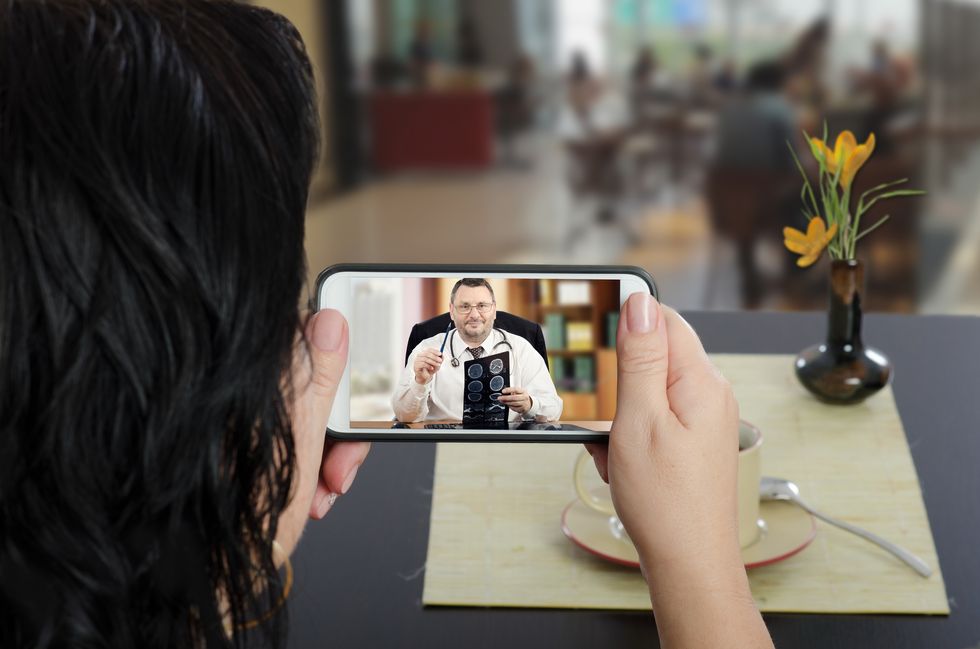By Steven Findlay, Kaiser Health News
May 9, 2018
Tucked into the federal budget law Congress passed in February was a provision that significantly expands the use of telemedicine — long a hyped health care reform, and now poised to go mainstream within five to 10 years.
"There's much broader recognition of the benefits," said Mei Wa Kwong, executive director of the Center for Connected Health Policy, a research group that promotes telemedicine in Sacramento, Calif. "The law is the latest to make telemedicine more accessible. But we still have a ways to go before most consumers are aware of the option."
The new law allows Medicare to cover telemedicine services for people who have had a stroke and those who get kidney dialysis, either at home or at a dialysis facility. It also permits Medicare Advantage Plans — private plans that enroll a third of Medicare beneficiaries — to offer telemedicine as a covered benefit.
Separately, as of Jan. 1, Medicare began allowing doctors to bill the government for monitoring certain patients remotely using telemedicine tools — for example, tracking heartbeat and rhythm, blood pressure and blood glucose levels.
Telemedicine, also referred to as telehealth, uses computers — and their display monitors, software and capacity for data analysis — to deliver virtual health services.
In the easiest-to-understand example, a patient is in one location and has an e-visit with the doctor in another location. They are connected via a secure video link. Proponents say that more sophisticated monitoring is on the horizon and that virtual encounters will become more commonplace.
As acceptance and adoption of telemedicine expands, so does coverage. All private health plans, Medicare, state Medicaid programs and the Department of Veterans Affairs now cover some e-visits — albeit with restrictions. More health centers and hospitals are launching virtual health centers. And websites offering virtual "doctor-on-demand" services are proliferating.
Concerns exist, however. Doctors worry that they may get paid less if insurance reimbursement is lower for e-visits than in-person appointments, or that e-visits could undermine the doctor-patient relationship by reducing valuable face time. They point out that for some ailments, like strep throat, it's best if doctors or other health providers see the patient.
Health economists, meanwhile, are concerned that e-visits could add to costs rather than constrain them — if, for example, doctors and patients abuse e-visits by scheduling them unnecessarily because they are quick and easy. Also, insurers may be motivated to push doctors to do more e-visits instead of in-person visits to save money. And for some people, access to proper equipment or internet access can be difficult.
"The potential for abuse is there," says Dr. Robert Berenson, a Medicare expert at the Urban Institute. "We will need to prevent gaming and misuse of the system. But, generally, helping people avoid unnecessary doctor's office and hospital visits is a good thing, if we do it right."
Here's a briefing on telemedicine basics:
Q: Are e-visits available from most hospitals and doctors?
Not yet. But access is increasing. Ask your doctor, clinic or hospital.
In some cities, medical centers are setting up telehealth "hubs" to handle patients. For example, Penn Medicine in Philadelphia launched its Connected Care center in February with 50 full-time employees, 24/7 access to care and a program to treat chronically ill patients at home. Some of the center's e-visit services are open only to Penn Medicine employees, but other services are available to anyone, with a focus on residents of Pennsylvania, New Jersey, Delaware and Maryland, said Bill Hanson, vice president and chief medical information officer at Penn Medicine.
Similarly, Mercy Virtual in Chesterfield, Mo., a St. Louis suburb, serves patients throughout the Midwest, and those treated at Mercy Health's network of 44 hospitals in five states. Launched in 2015, Mercy Virtual provided care to 750,000 people in 2017 with a team of 700 doctors, nurses and support staff.
Other medical centers with virtual health programs include Avera Health based in South Dakota; Cleveland Clinic in Ohio; Dignity Health in San Francisco; Intermountain Healthcare in Utah; and Kaiser Permanente, a managed-care health system in California and elsewhere.
Kaiser Permanente reported last year that 21 percent of its 110 million patient interactions in 2015 were e-visits. Officials there predict that by 2020 e-visits will exceed in-person visits. (Kaiser Permanente is not affiliated with Kaiser Health News, which is an editorially independent program of the Kaiser Family Foundation.)
Q: What restrictions do health plans, Medicare and Medicaid put on e-visits?
Health plan coverage varies, but most private insurers cover e-visits, and 34 states and the District of Columbia require that they do. A few states still require that a patient relationship be established with an in-person visit before the provider can bill for an e-visit. Check with your insurer about its policies.
Medicare's coverage of e-visits is more restrictive. First, e-visits must take the place of an in-person visit. Second, with exceptions allowed under February's budget law, Medicare largely restricts e-visits to those that occur in rural areas that have a shortage of doctors and/or hospitals. And third, most e-visits can't occur when the patient is at home. They can be done from a variety of other locations, such as a rural health clinic, a dialysis center or skilled nursing facility. A bill in Congress would loosen that restriction.
In contrast, almost all state Medicaid programs cover e-visits in the home. But restrictions still apply. For example, only 22 states cover remote patient monitoring for Medicaid enrollees.
The Telehealth Resource Centers, a federally funded organization promoting telemedicine and providing consumer information, has detailed explanations of e-visit restrictions and limitations.
Q: Do I need special computer equipment?
No. E-visits and other forms of telemedicine are done over commonly available computers, laptops, tablets and smartphones — and are typically encrypted to protect privacy. Specialized equipment is usually needed for remote monitoring, such as blood pressure or heart rate. One vexing barrier: broadband availability in rural areas. Also, millions of low-income and older Americans still lack Wi-Fi in their homes.
Q: What services can I get through telemedicine?
Most e-visits are for primary care or follow-up services, such as assessing symptoms or checking on people who have had a medical procedure. But a growing number — no one keeps national statistics — cater to people with chronic conditions who are being monitored at home, said Kwong.
Dermatology e-visits are becoming especially common. You can send a close-up photo of a skin rash, mole or other problem for an immediate assessment. Psychotherapy by e-visit is also expanding.
Sometimes an e-visit may provide an initial medical assessment for an injury, wound or illness that is clearly not life-threatening. Some cities are testing ambulance services that use telemedicine to triage whether people need a trip to the hospital.
Q: Will I save money if I do an e-visit instead of going into the doctor's office?
E-visits are generally less expensive than a trip to the doctor, but you may not see the difference if your insurance covers both with only a small copay or no copay. If you have a large deductible, however, an e-visit may mean you pay less out-of-pocket for that encounter.
Some states require insurers to make equal reimbursements for in-office and telemedicine consultations on simple matters.
Q: Are there downsides or risks with telemedicine and e-visits?
There's no evidence so far that your risk of being diagnosed wrongly or treated inappropriately is any greater with an e-visit compared to an in-person visit.
Kaiser Health News (KHN) is a national health policy news service. It is an editorially independent program of the Henry J. Kaiser Family Foundation which is not affiliated with Kaiser Permanente.







